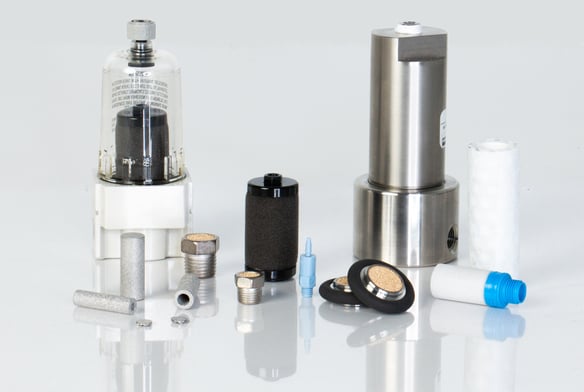Filtration implementation and design are critical, yet sometimes overlooked in pneumatic pressure generation and measurement systems.
In some common use cases, like topping off the air pressure of the tires on your vehicle, filtration is rarely needed. However, filtering is required or preferred to some degree for industrial applications like pneumatic actuation, solenoid valves, and instrumentation processes. These systems can be degraded or damaged by moisture and/or particulate contamination without the presence of effective filtration systems. This is where a filtration design begins.Filters used for pneumatic media can range from a simple sintered metal element to a fiber based coalescing filter, and applications sometimes use a combination of several filter types! The basis of the filtration design will depend on the type of debris expected to interact with the system, the sources of that debris and its point of entry into the system. The purpose of this post is to promote awareness of this all too common problem that has plagued the pneumatic industry in general, and can be especially detrimental to sensitive and high accuracy pneumatic instrumentation.

In-port Sintered Filters
Precision pneumatic products like pressure controllers benefit from having in-port filtration built in to them. These filters primarily protect the instruments against particulate matter such as debris that is often found in pressure sources in industrial manufacturing or verification environments in production. The filtration is carried out by enabling the pressure/gas flow through the filtering element from the outside to the inside. The size of the particle removed depends on the grade of the filtering element.
This is why the ports of all Mensor pneumatic pressure controllers are protected by a cartridge type sintered stainless steel filter ranging from 20µ to 40µ (µ is short form expression for “micron”). Such filters protect against most particulate matter found in dry air or nitrogen, however they provide no protection against moisture or liquid contamination. Over time, these filters can become clogged with collected debris that can cause poor controller performance due to restricted pressure flow. It is recommended to replace sintered in-port filters periodically based on the environment of operation and use.
Coalescing Filters
Coalescing filtration is the removal of fluid aerosols and droplets from a pneumatic supply. Typically, a coalescing filter element is installed in a housing with three ports: an inlet port for the "dirty" supply, an outlet port for the filtered output, and a drain port for the liquid the filter captures. The filter element typically consists of a high efficiency coalescing layer on the inside, and a coarse drainage layer on the outside.
Protection from moisture and fluids is of utmost importance for pneumatic precision instrumentation. Without proper filtration, moisture can accumulate on pressure sensing elements, causing their performance to degrade outside of their accuracy specification well before the calibration cycle is complete. Most reference standards like deadweight testers and piston gauge instruments require heavy particulate and moisture filtering for optimal performance. Unlike controllers, these devices have generally low pressure flow, so a particulate filtering of 20µ or more should be used.
Primary pressure reference standards will typically specify clean dry instrument quality air or dry nitrogen gas as their supply source. However, a coalescing filter is important when a sensitive instrument calls for a procedural venting to the atmosphere, or when these premium pressure standards are used in "gauge" mode. As an example, the CPD8500 Digital Deadweight Tester uses a coalescing filter when the internal vacuum is bled to the atmosphere. This is to prevent any moisture in the ambient air from finding its way in to the measuring elements of the device.
Overall, the benefits of using in-port and/or coalescing filters heavily outweigh their cost and the additional time required to clean them as they ensure stress free operation of cost sensitive pneumatic precision calibrators. Per ISO 8573-1, it is always recommended to use clean dry nitrogen as the pressure source to any pneumatic measurement device.
Related Reading:


